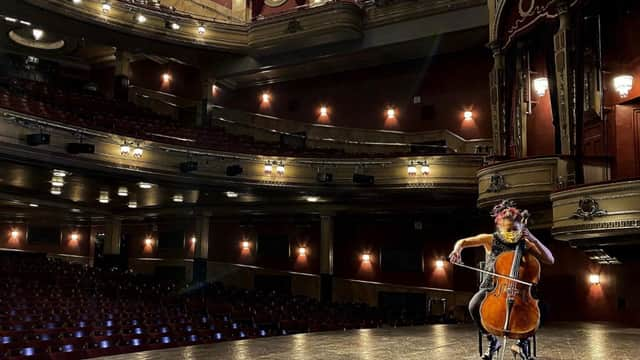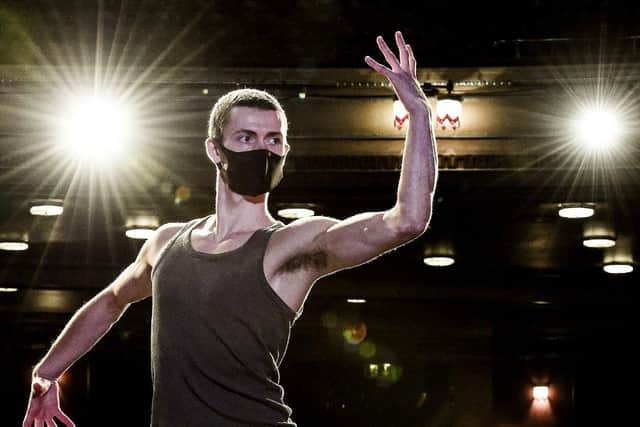Scotsman critics preview the Edinburgh International Festival


KEN WALTON ON CLASSICAL MUSIC
It may not be the live action extravaganza we’d expect from an Edinburgh International Festival, but, in the words of director Fergus Linehan, “for the first time since lockdown, orchestras, ballet companies, traditional musicians, theatre ensembles and designers have come together to perform in and light up the venues they love”.
No, we won’t be sensing the actual bodily presence of the Royal Scottish National Orchestra, Scottish Opera or solo stars like pianist Paul Lewis in the same room. But through creative ingenuity bespoke performances will be available digitally to a global audience via the Festival’s YouTube channel and a sound-equipped Princes Street Gardens during the three-week programme.
Advertisement
Hide AdIt’s Scotland’s first major attempt to lift a silenced classical music industry out of the doldrums, like a reawakening from an induced coma. As such, everything is still scaled down from the norm, but what there is smacks of immediacy and distinctive thought.
From Scottish Opera there’s a brand new update of Menotti’s short opera The Telephone by director Daisy Evans, a gift for Covid times with only two main characters and chamber orchestra. Filmed in the King’s Theatre bar, what was originally a 1940s satire on the curse of the telephone now translates to a whimsical pot shot at today’s smartphone culture.
From the Usher Hall, the RSNO tackle Mahler on a reduced scale - Klaus Simon’s nuclear arrangement of the monumental Symphony No 7, but also featuring the molten mezzo-soprano voice of Karin Cargill in three of Mahler’s Rückert Lieder. This is music director Thomas Søndergård’s EIF debut. The Scottish Chamber Orchestra mark Beethoven’s beleaguered 250th anniversary year with the Second Piano Concerto and pianist Paul Lewis.
Where’s the Edinburgh Festival Chorus in all this? They’ve been hard at work filming and recording from their own homes their individual parts to two symbolic movements from Carl Orff’s dramatic cantata Carmina Burana - the iconic O Fortuna, expressing fate’s cruel blow; and Ecce Gratum, which chorus director Aidan Oliver describes as “all about emerging from the harshness of winter into the joys of spring and summer and the resumption of jolly things.”


The Festival’s daily Queen’s Hall recitals may be absent, but EIF music boss Andrew Moore has put together a set of chamber music events, filmed behind closed doors between 10 and 28 August at The Hub, which can be experienced as “a chamber music soundscape” in Princes Street Gardens during weekday lunchtimes, or viewed on You Tube. Highlights will also be broadcast on Classic FM with presenter John Suchet.
Artists include tenor Nicky Spence and pianist Malcolm Martineau, cello-piano duo Philip Higham and Susan Tomes, members of the BBC SSO in Mendelssohn’s sparkling Octet, piano supremo Steven Osborne, the Elias String Quartet, Angela Hewitt with members of the RSNO, the Dunedin Consort, Hebrides Ensemble, and a whole lot more. In a separate initiative, violist Lawrence Power records a world premiere by Esa-Pekka Salonen from the Queen’s Hall. Bulking things up are a digital series of Usher Hall concerts from the EIF archives, and a Radio 3 series featuring Queen’s Hall broadcasts from previous festivals.
JOYCE MCMILLAN ON THEATRE
Advertisement
Hide AdGhost Light was the first title that came to mind, when the Edinburgh International Festival team started to put together their “ghost” programme for 2020; although in the end they embraced a more upbeat alternative. Ghost lights are the tiny lights traditionally left burning on the stages of theatres that are closed and dark; and it remains the chosen title of the theatre element of the filmed celebration of the arts that will go live online on Saturday evening, to launch the virtual Festival.


Ghost Light is a one-hour film created for and with the National Theatre of Scotland by writer and director Hope Dickson Leach, and described as “a personal love letter to theatre in Scotland”, which seeks - by embracing the power of a very different art-form - to capture the special, irreplaceable magic of live theatre, as it faces the unique threat of the Covid-19 epidemic.
Advertisement
Hide AdThe result is a film - put together with dramaturgical guidance from former Traverse director Philip Howard - that aims to celebrate the past, present and future of Scottish theatre through clips from old productions, glimpses of shows that would have been playing this spring and summer, and three commissions of new work never seen before. The film features a tremendous gallery of Scottish theatre stars and theatre-makers, both onstage and backstage, and also seeks to celebrate the great theatre buildings of Scotland, currently lying empty; it was substantially filmed at the Festival Theatre in Edinburgh, once the old Empire. “I just wanted to make a film that was in love with theatre,” says Dickson Leach, “both with the emotional response it can create, and with the sheer hard human labour that goes into making it. And I really hope we’ve succeeded.”
Ghost Light will be available online from Saturday; but viewers will have to wait until later in the month for a glimpse of the Edinburgh International Festival’s 2020 collaboration with the Traverse, a new film inspired by the Traverse’s smash-hit 2018 show Mouthpiece, by Kieran Hurley, about the relationship between a middle-aged female playwright, and the working-class Edinburgh boy whose story helps her revive her flagging career. Titled Declan, the film is directed by Lorn Macdonald, who played the role of the boy, Declan, in the original production.
“We’re delighted that Declan’s story is being given a new lease of life, embedded firmly in the Edinburgh landscape where it’s set,” says the Traverse’s Executive Producer Linda Crooks. “Declan still has much more to say, about issues of cultural appropriation and exclusion – and it is imperative that we listen, and ensure that post-Covid, we create culture which is truly representative, and accessible to all.”


KELLY APTER ON DANCE
After months of taking classes on Zoom and trying to keep themselves fit at home, Scottish Ballet’s dancers finally headed back to their Glasgow studios last month. Operating in two distinct “bubbles,” with spaces disinfected between groups, they’ve rapidly put together a diverse collection of seven short films as part of Edinburgh International Festival’s My Light Shines On programme.
Some we’ve seen before – the excellent Frontiers, Tremble and Prometheus & Epimetheus from Scottish Ballet’s 2019 Digital Season. Some we’ve seen live, such as Helen Pickett’s Trace and Sophie Laplane’s Oxymore, now shot in interesting locations around the company’s Tramway premises. But, despite the extenuating circumstances, there’s also a brand new work in the mix.
“When we were first asked to get involved, I felt kind of on the back foot,” says Scottish Ballet’s artistic director, Christopher Hampson. “Because as a company we’re really not going to be performance fit for another six weeks, so I had to choose repertoire that was achievable in the time we had. But I thought Scottish Ballet cannot be in the Festival without doing something new.”
Advertisement
Hide AdAs a result, dancer Nicholas Shoesmith has found himself thrust into the limelight. A burgeoning choreographic talent within the company, he has created a five-minute work for all 38 dancers. Rehearsed in the studio bubbles, Catalyst was then filmed on the Edinburgh Festival Theatre stage, within social distancing guidelines.
After months of not knowing what the next week will bring, for Hampson and the dancers having a fixed project to work on has been a difficult but welcome gift.
Advertisement
Hide Ad“It’s been really challenging,” he says. “But it just meant we had to be more creative and double down on what the possibilities are, not the limitations. Behind the scenes we’ve never worked harder, because we’re constantly re-planning, so to focus on the Festival has been wonderful.”
SUSAN MANSFIELD ON VISUAL ART
WHEN Edinburgh International Festival picked up the phone to two Scottish lighting designers, Kate Bonney and Simon Hayes knew they were being offered the opportunity of a lifetime. “The opportunity to light up a whole city doesn’t come along very often,” says Bonney, who, with Hayes, designed The Enchanted Forest near Pitlochry. “This wouldn’t be possible if we weren’t in the circumstances we are in.”
Bonney and Hayes were asked by EIF to do two things: to light up venues which would normally host festival productions, inspired by the "ghost lights” left on when theatres are dark, and to create a spectacle of light beamed into the sky across the city. The result, entitled My Light Shines On, opens on 8 August and will be visible after dark.
Bonney says: “Rather than just a single lightbulb, we’ve filled some of the theatre foyers with lights which would normally be lighting up the stage, celebrating the audiences and the professionals who should be in that building.” At three city theatres, they have also lit the stage doors, in a specific tribute to the artists currently unable to do their jobs.
But creating a city-wide spectacle of light in a time of pandemic has particular restrictions. In order to deter people gathering in groups to see the show, the designers emphasise that elements should be visible in the sky to almost anyone with an EH postcode.
“If we went all bells and whistles and made a lighting installation full of contrast and colour, we run the risk of creating a mass gathering,” says Hayes. “We’re being asked to make the biggest spectacle you’ve ever seen, and if nobody goes out to see it we’ve done our jobs!”
Advertisement
Hide AdDancing searchlights will beam across the sky from spaces normally throbbing with festival energy, including the Usher Hall, Charlotte Square, Bristo Square and the Castle Esplanade. “Sometimes it will be structured and geometric, sometimes scattery and messy,” says Bonney. “We want it to reflect all the things we normally feel in August.”
A large-scale project which would normally take six months or more to create has been brought together in just two, but the lack of darkness in June and July means the team has had to do their best work in the few hours between sunset and sunrise. Unusual light activity around Edinburgh has called widespread speculation - including at least one call to NASA to ask if they knew the cause.
Advertisement
Hide AdBoth designers are aware of the sensitivity the circumstances require: they must commemorate a cancelled festival while celebrating the energy of festivals past and future; they must make a spectacle which can be seen by all, but delivered with (no pun intended) a light touch. Kate laughs: “As understated as 250 beams of light shining into the sky can be!”
For full Edinburgh International Festival listings, visit www.eif.co.uk
A message from the Editor
Thank you for reading this story on our website. While I have your attention, I also have an important request to make of you.
With the coronavirus lockdown having a major impact on many of our advertisers - and consequently the revenue we receive - we are more reliant than ever on you taking out a digital subscription.
Subscribe to scotsman.com and enjoy unlimited access to Scottish news and information online and on our app. With a digital subscription, you can read more than 5 articles, see fewer ads, enjoy faster load times, and get access to exclusive newsletters and content. Visit https://www.scotsman.com/subscriptions now to sign up.
Joy Yates
Editorial Director